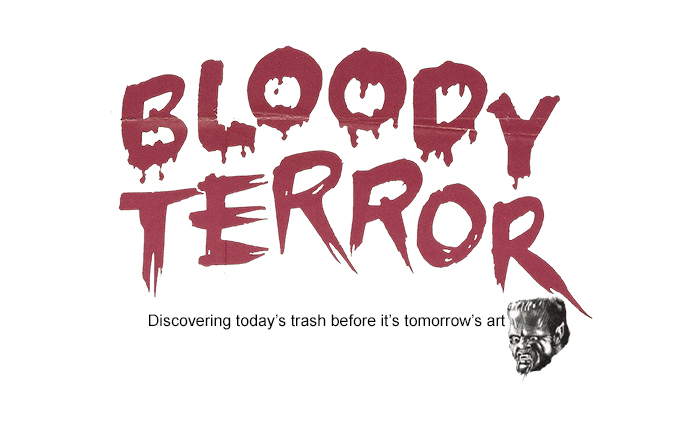
Last night I watched a very interesting movie: “The Blood Spattered Bride”. This wasn’t my first attempt at watching it; I’d rented the MPI/Gorgon VHS in the 80’s and didn’t make it all the way through. What I watched in the 80’s was a soft looking, boring, and unbeknownst to me, heavily cut version of the original 1972 Spanish release. What I watched last night was the uncut Blue Underground DVD, included as a “special feature” on their 2-Disc “Daughters of Darkness” release. What a difference.
The movie begins immediately post-wedding as a young bride (Maribel Martín – “The House That Screamed”, “A Bell From Hell”) and her 30-something husband (Simón Andreu – “Death Walks on High Heels”) arrive at a hotel for their honeymoon. While Simón parks their car, Maribel catches a glimpse of a woman who is sitting in another vehicle, watching the young bride.
Inside, Maribel is alone in the hotel room. She hangs her wedding veil in a wardrobe. Suddenly, her husband appears and attacks her. He strangles his bride, then rips her wedding gown from her body. With Maribel unconscious and nude on their bed, Simón rapes her.
Cut to the hallway outside of the room as Simón arrives at the door. He enters to find his bride sitting on the bed still wearing her thoroughly intact wedding gown. Though upset, Maribel has imagined the attack.
No longer wanting to stay at the hotel, Simón takes Maribel to his family estate inhabited by only the caretakers and their 12-year-old daughter. Here, Maribel and Simón will proceed with their honeymoon. Up until this point, Simón has been nothing but kind to his new bride. Alone with her in their bedroom, however, he roughly tears the wedding gown from his wife’s body as in Maribel’s earlier hallucination. The couple then proceeds to have consensual sex, Maribel losing her virginity.
As time passes, Simón’s sexual demands become more degrading, and a power struggle develops between the two. Adding to the gender conflict, Maribel notices that all of the family portraits hanging in the estate are of men. She asks the caretakers’ daughter about it and the girl tells Maribel that the womens’ portraits are all in the basement, the result of one of the brides killing her husband on their wedding night. The girl takes Maribel to see the portraits and a connection starts building between Maribel and the murderess.
Of course, the woman (Alexandra Bastedo – the ’67 version of “Casino Royale”) who was eyeing Maribel from the car parked outside the hotel in the film’s opening appears again. The scene in which Simón discovers her on a beach is incredible, half hilarious and half amazing. Its overall effect is surreal and appropriate if you accept it. And since “The Blood Spattered Bride” is loosely based on Sheridan LeFanu’s “Carmilla”, the film enters lesbian vampire territory, a popular theme in 70’s horror flicks represented in particular by a string of films from Europe (“Daughters of Darkness”, “Vampyres”, “The Vampire Lovers”, “Vampyros Lesbos”).
Not being a big fan of vampire movies, I liked that “Bride” kept its bloodsucker elements to a minimum, focusing instead on Maribel’s possibly disintegrating sanity (à la “Repulsion”) and her relationship with her husband, providing some striking and indelible images as it does so (in the bird cage, on the beach). There is also an abundance of sexual imagery and metaphors in “The Blood Spattered Bride”, many of them violent and sexual at the same time: daggers, animal traps, castration, and even the movie’s title is suggestive and vaguely reminiscent of Maribel’s bride losing her virginity. The use of the wedding gown and veil as symbols is also strong and evocative in the way that they are treated by Simón, Maribel, and Bastedo’s characters.
Like most good horror movies, what’s particularly fascinating about “Bride” is in receiving the messages regarding what the movie is really about beneath the breasts and blood. In this case, it’s clearly about gender and the relationship between the sexes. But what is it saying? Is it a reaction against the burgeoning women’s rights movement of the 70’s, or does it support it? Despite the fact that there is an imbalance in the ratio of female nudity (some) to male nudity (none) on display in “Bride”, happily I don’t think director Vicente Aranda is on either side with this movie. He seems content to raise questions and not provide answers, letting the viewer ponder the issues. To be certain, the second last shot of the movie is provocative and easy to misinterpret (maybe intentionally so). This moment can only account for the final shot of the film that highlights a newspaper headline clarifying the unsettling image that preceded it.
The movie itself is deliberately paced, building character and its plot and themes steadily, giving all three more impact as they revel themselves. While it contains gothic locations and elements typical to vampire flicks, “Bride” is a contemporary movie more concerned with Freud than Stoker. Its images, plot, and themes provide enough food for thought long after the DVD has been removed from the player, adding a welcome bent to a well-worn sub-genre. The one negative criticism that I’ll offer as a warning is that, like too many 70’s Euro-horror flicks, “Bride” includes one scene of actual on-screen animal death that could have been faked without losing its impact.
Now one of my favourite flicks, “The Blood Spattered Bride” joins “Who Can Kill a Child?”, “The House That Screamed”, “A Bell From Hell”, the Blind Dead series, and the films of Paul Naschy in a list of essential Spanish horror movies that are being rediscovered and reevaluated by horror fans. It can also easily claim its place along side “Rosemary’s Baby” and “The Silence of the Lambs” as that rare film that successfully tackles gender issues without being ham-fisted and obvious (I’m talking to you, "Themla and Louise").

